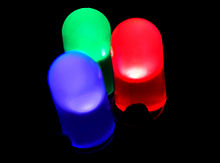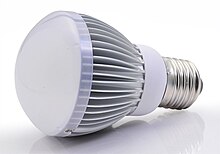
Back ثنائي باعث للضوء Arabic পোহৰ নিৰ্গতক ডায়'ড Assamese Led AST İşıq diodu Azerbaijani Святлодыёд Byelorussian Сьвятлодыёд BE-X-OLD Светодиод Bulgarian আলোক নিঃসারী ডায়োড Bengali/Bangla Svijetleća dioda BS Díode emissor de llum Catalan
 Blue, green, and red LEDs in 5 mm diffused cases. There are many different variants of LEDs. | |
| Working principle | Electroluminescence |
|---|---|
| Invented |
|
| First production | October 1962 |
| Pin configuration | Anode and cathode |
| Electronic symbol | |
 | |



A light-emitting diode (LED) is a semiconductor device that emits light when current flows through it. Electrons in the semiconductor recombine with electron holes, releasing energy in the form of photons. The color of the light (corresponding to the energy of the photons) is determined by the energy required for electrons to cross the band gap of the semiconductor.[5] White light is obtained by using multiple semiconductors or a layer of light-emitting phosphor on the semiconductor device.[6]
Appearing as practical electronic components in 1962, the earliest LEDs emitted low-intensity infrared (IR) light.[7] Infrared LEDs are used in remote-control circuits, such as those used with a wide variety of consumer electronics. The first visible-light LEDs were of low intensity and limited to red.
Early LEDs were often used as indicator lamps, replacing small incandescent bulbs, and in seven-segment displays. Later developments produced LEDs available in visible, ultraviolet (UV), and infrared wavelengths with high, low, or intermediate light output, for instance, white LEDs suitable for room and outdoor lighting. LEDs have also given rise to new types of displays and sensors, while their high switching rates are useful in advanced communications technology with applications as diverse as aviation lighting, fairy lights, strip lights, automotive headlamps, advertising, general lighting, traffic signals, camera flashes, lighted wallpaper, horticultural grow lights, and medical devices.[8]
LEDs have many advantages over incandescent light sources, including lower power consumption, a longer lifetime, improved physical robustness, smaller sizes, and faster switching. In exchange for these generally favorable attributes, disadvantages of LEDs include electrical limitations to low voltage and generally to DC (not AC) power, the inability to provide steady illumination from a pulsing DC or an AC electrical supply source, and a lesser maximum operating temperature and storage temperature.
LEDs are transducers of electricity into light. They operate in reverse of photodiodes, which convert light into electricity.
- ^ "HJ Round was a pioneer in the development of the LED". www.myledpassion.com. Archived from the original on October 28, 2020. Retrieved April 11, 2017.
- ^ "The life and times of the LED — a 100-year history" (PDF). The Optoelectronics Research Centre, University of Southampton. April 2007. Archived from the original (PDF) on September 15, 2012. Retrieved September 4, 2012.
- ^ US Patent 3293513, "Semiconductor Radiant Diode", James R. Biard and Gary Pittman, Filed on Aug. 8th, 1962, Issued on Dec. 20th, 1966.
- ^ "Inventor of Long-Lasting, Low-Heat Light Source Awarded $500,000 Lemelson-MIT Prize for Invention". Washington, D.C. Massachusetts Institute of Technology. April 21, 2004. Archived from the original on October 9, 2011. Retrieved December 21, 2011.
- ^ Edwards, Kimberly D. "Light Emitting Diodes" (PDF). University of California, Irvine. p. 2. Archived from the original (PDF) on February 14, 2019. Retrieved January 12, 2019.
- ^ Lighting Research Center. "How is white light made with LEDs?". Rensselaer Polytechnic Institute. Archived from the original on May 2, 2021. Retrieved January 12, 2019.
- ^ Cite error: The named reference
FirstPracticalLEDwas invoked but never defined (see the help page). - ^ Peláez, E. A; Villegas, E. R (2007). "LED power reduction trade-offs for ambulatory pulse oximetry". 2007 29th Annual International Conference of the IEEE Engineering in Medicine and Biology Society. Vol. 2007. pp. 2296–9. doi:10.1109/IEMBS.2007.4352784. ISBN 978-1-4244-0787-3. ISSN 1557-170X. PMID 18002450. S2CID 34626885.